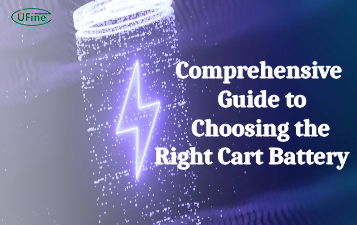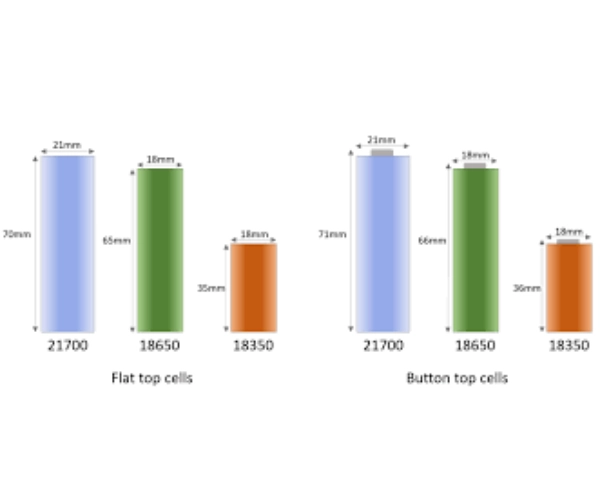In the world of rechargeable batteries, the 18650 battery has gained significant popularity due to its versatility and long-lasting power. People commonly use these batteries in various applications, including flashlights, laptops, and electric vehicles. Regarding 18650 batteries, one aspect that often confuses consumers is choosing between flat top and button top variants. In this article, we will explore the differences between flat top and button top 18650 batteries, their pros and cons, and considerations for choosing the right one for your needs.
Part 1. 18650 Flat top battery
Definition:
A flat-top 18650 battery is a cylindrical lithium-ion battery with a flat positive terminal. It lacks the protruding button found on the positive end of the battery. The flat top design allows for a more compact form factor, making it suitable for devices with tight battery compartments.
Pros:
- Compact Size: The absence of a protruding button makes flat top 18650 batteries more compact, enabling them to fit into devices with limited space.
- Versatility: Flat-top batteries are compatible with a wide range of devices that require 18650 batteries, including flashlights, vaporizers, and power tools.
- Enhanced Safety: The flat design reduces the risk of accidental short-circuits when inserting or removing the battery from the device.
Cons:
- Limited Compatibility: Some devices, particularly those designed to accommodate button-top batteries, may need to be compatible with flat-top variants. The absence of a button can prevent proper electrical contact in such cases.
- Lower Capacity: Due to their compact size, flat-top batteries may have slightly lower capacity than their button-top counterparts. This means they may provide somewhat less runtime in specific devices.
Part 2. 18650 Button top battery
Definition:
As the name suggests, a button top 18650 battery features a protruding button on the positive end of the battery. Many often refer to this design as a raised or protruding positive terminal.
Pros:
- Compatibility: Button-top batteries are suitable for devices specifically designed to accommodate this type of battery. They ensure proper electrical contact, particularly in devices with spring-loaded battery compartments.
- Higher Capacity: Button-top batteries often have a higher capacity than flat-top variants. This means they can provide longer runtime in devices with high power consumption.
Cons:
- Size Limitations: The protruding button design makes button-top batteries slightly more significant than their flat-top counterparts. This can be a limitation in devices with tight battery compartments.
- Potential Short-Circuit Risk: The raised button increases the chances of accidental short-circuits if the battery comes into contact with conductive materials when not in use or during storage.
Part 3. Differences between flat top and button top 18650 batteries
Dimensions:
- Flat top 18650 batteries have a flat positive terminal, which means the positive terminal is flush with the top of the battery.
- Button top 18650 batteries feature a protruding positive terminal resembling a small button on top of the battery.
Compatibility:
- People commonly use flat-top batteries in devices with spring-loaded or sliding battery compartments that accommodate flat terminals.
- Users prefer button-top batteries for devices with fixed or rigid battery compartments explicitly designed for button-top terminals.
Contact Surface:
- The flat-top battery design of the positive terminal may provide a larger contact surface area in some devices, potentially improving connectivity.
- The positive terminal’s button top battery protruding nature ensures direct contact with the battery contacts in devices with recessed or limited battery compartments.
Device Suitability:
- Devices with flexible battery compartments and those designed for flat-top batteries are suitable for flat-top 18650 batteries.
- Devices with fixed or specialized battery compartments, particularly those requiring button-top batteries, are compatible with button-top 18650 batteries.
Handling:
- Flat-top batteries may be easier to handle and insert into devices with spacious or open battery compartments due to their flat profile.
- Button top batteries are advantageous for devices with specific battery compartment designs, as the protruding terminal aids alignment and insertion.
Application:
- Flat-top batteries are versatile and widely used in various electronic devices, including flashlights, laptops, and electric vehicles.
- Users prefer button-top batteries for devices requiring a protruding positive terminal, such as flashlights and specific vaping devices.
Design:
- The flat design of flat-top batteries may provide a sleek and uniform appearance when installed in compatible devices.
- The button-shaped terminal of button-top batteries adds a distinctive feature to devices designed to accommodate them, enhancing aesthetics in some cases.
Part 4. Considerations for choosing between the flat-top and button-top batteries
When deciding between flat top and button top 18650 batteries, users should consider several factors:
Device Compatibility
Determine whether your device requires a specific type of battery. Some devices may explicitly state the compatibility requirements or have physical limitations requiring flat-top or button-top batteries.
Space Constraints
Assess the available space within your device’s battery compartment. A flat-top battery may be a better fit if it has limited space. However, a button-top battery can provide higher capacity and longer runtime if space is not a concern.
Power Requirements
Consider the power demands of your device. A button-top battery with a higher capacity may be more suitable if it requires high power consumption. For devices with lower power demands, a flat-top battery should suffice.
Safety
Evaluate the safety implications of each design. Flat-top batteries reduce the risk of accidental short-circuits. In contrast, button-top batteries may be more prone to such incidents if not stored properly.
Part 5. Conclusion
The choice between flat and button top 18650 batteries depends on device compatibility, space constraints, power demands, and safety considerations. Flat-top batteries offer versatility and compact size, while button-top batteries provide better compatibility with specific devices and higher capacity for sustained high-power output. By evaluating these factors, you can select the most suitable battery variant for your needs and ensure optimal performance and safety.
Related Tags:
More Articles

Comprehensive Guide to Choosing the Right Cart Battery
Choosing the right cart battery ensures optimal performance and longevity. This guide covers cart battery types and helps you make an informed choice.
The Ultimate Guide to 18650 Button Top Battery
18650 button top batteries are popular for their high energy density and reliability. This guide covers their key features, usage, and maintenance tips.
The Power of Slim: Unveiling the Potential of Flat Lithium Ion Battery
Flat lithium-ion batteries power devices from phones to vehicles. This article explores their design, benefits, types, applications, charging, and safety.
The Comprehensive Guide to Battery Balancing and Battery Balancer
Battery balancing and balancers optimize performance, longevity, and safety. This guide covers techniques and tips for choosing the right balancer.
10 Key Facts About Drone Battery for 2024
Uncover crucial insights with "10 Key Facts About Drone Battery for 2024." Learn the latest trends and essential details on drone batteries.




